
![]()

Susan Scales passed away on the 20th July 2000 after a long illness.

![]()

Susan Scales passed away on the 20th July 2000 after a long illness.
| The first Manymills litter was
born on 1st January 1960 and were advertised as "not dual purpose, but
multi purpose".
The sire was Foxhanger Mascot P.D.Ex. T.D.Ex.
W.D.Ex. U.D.Ex. C.D.Ex. and the dam Lisnamallard Peggy
U.D.Ex.C.D.Ex.
The Foxhangers, owned and trained by Lady
Simpson, at that time competed and won in all five disciplines available
to Labradors (breed showing, field trials, working trials, gundog working
tests and obedience) and my ambition was to do the same. We have had a British Field Trial Champion and a Working Trial Champion, and there have been Manymills champions in field and show ring all over the world. |
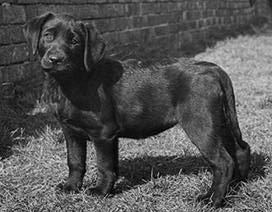
Manymills Lucky Charm W.D.Ex. U.D.Ex. C.D.Ex., aged 11 weeks. (1960)
| Lucky Charm, known as Pippin, was retained from my first litter and all subsequent stock has descended from her. She won 1sts in all five disciplines and was the dam (by Ch. Sandylands Tandy) of W.T.Ch. M. Tanne T.D.Ex. W.D.Ex. U.D.Ex. C.D.Ex. |

1974 - W.T.Ch. Manmills Tanne, Manymills Encore W.D.Ex. U.D.Ex.
C.D.Ex.,
Manymills Wigeon, Manymills Chief Scout and Manymills
Edwin of Creasser.
| Tanne became a W.T.Ch., won
22 Gundog Working Tests and a two day Open Field Trial. Encore
won Field Trials and Working Tests and qualified up to W.D.Ex. in Working
Trials. Wigeon and Chief Scout won F.T. & Ch. Show
awards. Manymills Edwin of Creasser (the only dog I ever bought not
of my own breeding) won Ch. Show 1sts and F.T. awards. Manymills stock were known for their wonderful temperaments and many become Guide Dogs, Dogs for the Disabled etc. as well as gundogs. They were good looking Labradors possessing the breed essentials of expression, coat and tail. |
![]()
6 Generations of consistent type, working ability and looks.

F.T.Ch.
Holdgate Willie (1st Crufts)

Holdgate Willie's son - Manymills Wigeon (Field Trial and Ch. Show
awards).
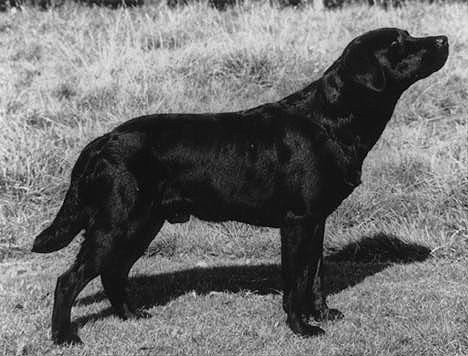
Wigeon's son - Manymills Drake C.D.Ex. (F.T. Open Stake winner &
10 Ch. Show 1sts).
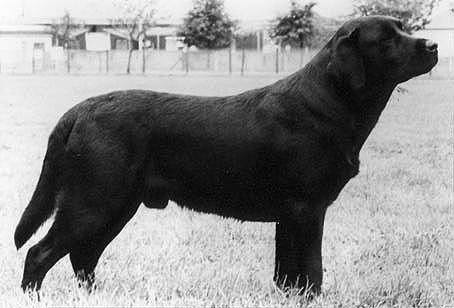
Drake's
son - Ch. Abbeystead Heron's Court (Field Trial awards).
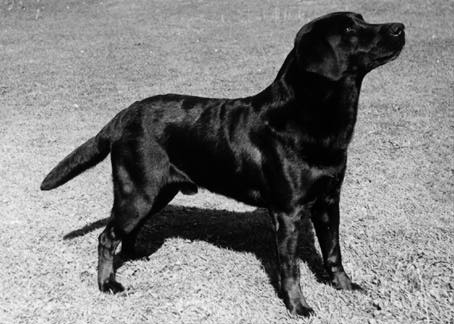
Drake's
son - Manymills Heron (5 Field Trial 1sts and Ch. Show 1sts).
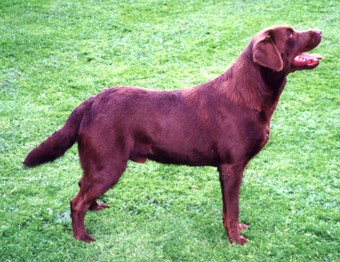
The 6th generation, Heron's son Malteser of
Manymills.
Aged 2 years.
| Malteser of Manymills | Manymills Heron | Ch. Abbeystead Herons Court |
Manymills Drake CDEx | Manymills Wigeon |
| Manymills Elsa UDEx CDEx | ||||
| Charway Seashell | Ch. Fabracken Comedy Star |
|||
| Charway Simona | ||||
| Manymills Ladybird | Manymills Drake CDEx | Manymills Wigeon | ||
| Manymills Elsa UDEx CDEx | ||||
| F.T.Ch. Manymills Milady |
Brenjon Earl of Bradenham | |||
| Manymills Kohl | ||||
| Rock Rose | Manymills Hobby | Ch. Abbeystead Herons Court |
Manymills Drake CDEx | |
| Charway Seashell | ||||
| Manymills Jaffa | Baas Hill Jason | |||
| Manymills Puffin | ||||
| Miss Millicent of Boutells | Manymills Toby | Lettermore William | ||
| F.T.Ch. Manymills Milady |
||||
| Boutells Little Amy | F.T.Ch. Mirstan Drummer |
|||
| Streamline Harp |
|
DUAL PURPOSE LABRADORS by Susan Scales In the early days of the breed working and show dogs came from the same bloodlines and were often the same dogs. Dual Champions existed, although few and far between. The first, Dual Ch. Banchory Bolo, was born in 1915 and the last, Dual Ch. Knaith Banjo, in 1946. The latter, along with Dual Ch. Staindrop Saighdear, were the only two yellows. The only bitch was Dual Ch. Lochar Nessie, born in 1933. The others, all black dogs, were Dual Chs. Banchory Sunspeck, Titus of Whitmore, Bramshaw Bob, Banchory Painter and Rockstead Footspark. As the breed increased in popularity, however, it inevitably split. In order for this not to have happened, all breeders would have had to give equal weight to working ability and good looks. As soon as one person began to aim for one in preference to the other, and to breed with this in mind, he would beat his rivals in the sphere he favoured and they would be forced to follow suit. This is in fact what happened. The same thing has taken place to a greater or lesser extent in all gundog breeds except those so newly imported that it has not had time to occur. Owners coming into the breed after the war, and even before it, were frequently only interested in either work or show, and they bred for what they required. This has resulted in a heavier, squarer show dog than was ever envisaged by those who laid down the original Standard, and a lighter, faster working dog than was intended originally. Over the years, however, there have always been some people who insisted either that their show dogs. could work or that their working dogs were good looking enough to show. Nevertheless I think it is fair to say that not for very many years have there been any breeders who have given equal importance to both aspects. If there were, by the nature of things they would be unlikely to progress very far in either sphere. If one runs in two direction at once one tends to stay on the same spot. There are a number of present day breeders who, although primarily interested in show, run some of their dogs in field trials and achieve awards with them. There are also a few whose major interest is working and field trials, but who insist on a certain standard of looks and sometimes produce a dog good enough to win in the show ring. If these two groups were to get together and use each other's dogs more than they do, there might be some hope of producing dogs capable of doing well in both spheres, but the odds would be against producing a dog able to go to the top in both even if show dogs and outstanding workers could be produced in the same litter. Another factor militating against the production of dual purpose dogs is the fact that the majority of present day show judges have no involvement with work and no idea of how a working dog should be built. They put up dogs which are too heavy and often too short, with thick stuffy necks and upright shoulders. These would be incapable of working on a shoot for more than half an hour without getting exhausted, still less with the speed and style demanded for trials.
Another dual purpose kennel was Whatstandwell and kennels which showed and also trialled some or all of their dogs included Holton, Mansergh, Cornlands, Braeduke, Liddly, Reanacre and Ardmargha. More recently Mrs. Macan with her Timsprings kept up the same tradition. Although not trialled, the Sandylands kennel has always had a reputation for good workers, and Ch. Sandylands Tandy sired at least one open stake winner. Over the last ten or fifteen years Champions with trial awards have included Ch. Squire of Ballyduff, Ch. Elowood Soul Singer and Ch. Abbeystead Herons Court. Soul Singer sired Meadowmill Tap On Wood, which won a reserve CC and a Novice Dog and Handler stake. He was also the grandsire of another reserve CC winner with trial awards, Westonholme Dark Warlock. On the other side, the entirely FT bred FT. Ch. Holdgate Willie came to Crufts in 1974 and won FT. Dog under the late Bridget Docking. Mrs. Benson's Holdgate kennel has produced several good looking dogs over the years, although they have not been shown except in the odd FT. class. It is a pity that Willie was not used at stud by the show fraternity. However, his grandson Manymills Drake CD Ex, himself a winner of an open stake and several championship show 1st prizes, was used on a show bitch to produce Ch. Abbeystead Herons Court. The latter dog is being used by some show breeders so maybe after all these years Willie will have an influence for good on the show as well as on the field trial lines. However, it is unfortunately true to say that the pure field trial strains almost never produce anything which could go very far in the show ring. Show strains might produce the occasional dog which could go a long way in trials, but most of them never get the opportunity. Those that do very often have novice owner/trainers who do not enhance their chances. If some of the top trainers could be persuaded to take on a show bred dog from a strain which has proved it can produce workers, we might see some better results. Arnold White-Robinson succeeded in making up to FT Ch the mainly show bred Stratfieldsaye Calcot Crossbow. He, however, was virtually ignored as a stud dog by show breeders. Neither was he much used by field trial people. It is not an uncommon fate for dual purpose dogs to be wasted at stud, as neither side are prepared to use them. The future for the dual purpose Labrador cannot do other than appear rather gloomy for the reasons I have given. I am sure, however, that there will always be a few people, including myself, whose working dogs must be typical looking Labradors and show people who insist on a certain measure of working instinct and ability in their dogs. Susan Scales |